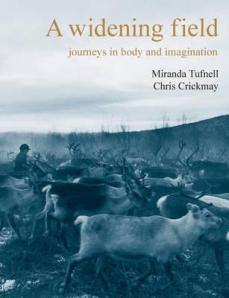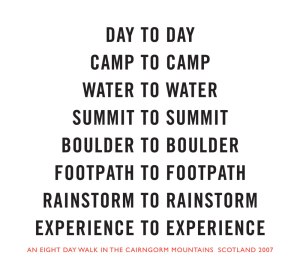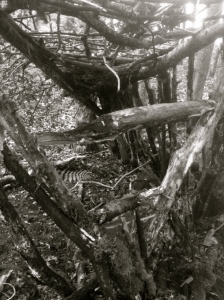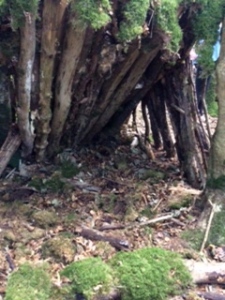Walking Studio Two Contrasts
March 17, 2021
The Walking Studio of Contrasts
Two contrasting walks in different parts of Ireland—Antrim Castle Gardens in Northern Ireland and the village of Chapelizod in Dublin located in the valley of the River Liffey. Two walkers on different paths.
“Walking is finding an impromptu studio in a place you never expected. Marking territory. Remembering. Picking up things. Making eye contact. A walk is never the same twice. Writing notes to self. Losing one’s way. Talking to yourself. A chat with a stranger. Going with the unexpected. Being surprised by what you find. Marking the journey with objects, the milestones of moments. Unexpected encounters. The desire to be in a new situation. Be somewhere different. Revisiting the past. Caught up with what’s going on. Making do. Taking the long way home. Getting as far away from home as possible. Being curious. Nonchalant. Indecisive. Having a route mapped out. Going off course. Letting things happen. Every so often taking a rest. Time-out. In between places. Both lingering and counting steps. Not knowing what’s around the corner” (Pamela Whitaker)
“Musing takes place in a kind of meadowlands of the imagination, a part of the imagination that has not yet been plowed, developed, or put to any immediately practical use…time spent there is not work time, yet without that time the mind becomes sterile, dull, domesticated. The fight for free space — for wilderness and public space — must be accompanied by a fight for free time to spend wandering in that space.”
― Rebecca Solnit, Wanderlust: A History of Walking
“Walkers are ‘practitioners of the city,’ for the city is made to be walked. A city is a language, a repository of possibilities, and walking is the act of speaking that language, of selecting from those possibilities. Just as language limits what can be said, architecture limits where one can walk, but the walker invents other ways to go.”
― Rebecca Solnit, Wanderlust: A History of Walking
Expressions Related to Walking: Walk of Life, Take a Walk Down Memory Lane, Walking Down A Dead End Street, All Walks of Life, Walk Away, Walk On, Walk the Talk, Walk Away From, Walk on Air, Walk Tall, A Move in the Right Direction, A Journey of Thousand Miles Begins with a Single Step, Change of Pace, Don’t Rain on my Parade










The Walking Studio Rivers
March 7, 2021







A river is a flow of life and a route of passage
A walk by the Tolka River in Dublin with a history dating back to the Bronze Age, Vikings, the Middle Ages, and in the 18th century the location of a village named Cardiffsbridge noted for its prominent mill and ironworks. There were also several castles and tower houses located in the area and there is a legend that St. Patrick once roamed and blessed the surrounding landscape. The Tolka is the second largest river in Dublin, and this walk along a river bank was accompanied by early morning sun transforming frost to spring growth.
It was the sound of the river that led me somewhere else in myself. The line of the river offered direction and motion.
river, waterway, stream, brook, tributary, inlet, rivulet, channel, creek, course, estuary

The Walking Studio Gardens
February 27, 2021
The Botanic Gardens (Dublin) is home to 17 000 plants from around the world including 300 endangered species. In size it is 50 acres featuring a pond, river, vegetable garden, wild plants, and flower displays. It is an ideal place to indulge in forest bathing within pine and cedar trees with scents that are invigorating. Forest bathing is dwelling in an atmosphere of trees that re-charges with a vigour of replenishment. The experience nurtures as an antidote to the strains and tensions in life and concentrations on urgency and preoccupations.
Forest bathing or shinrin-yoku is a wellbeing practice based in Japan that encourages time with trees for restoration of both mind and body. It is the rejuvenating elements of pine, cedar and eucalyptus that brings solace and optimism. In a botanic garden international species of trees form community and develop a companionship with the locals. The aroma of each tree’s essential oils is not only uplifting, but an immersive encounter with an environment that surrounds as a balm and a stimulus.
“Shinrin-yoku was developed in the 1980s in Japan. Although people had been taking walks in the country’s forests for centuries, new studies showed that such activity could reduce blood pressure, lower cortisol levels and improve concentration and memory. A chemical released by trees and plants, called phytoncides, was found to boost the immune system. As more research highlighted the benefits of shinrin-yoku, the Japanese government incorporated it into the country’s health programme” Harriet Sherwood (2019) Getting Back to Nature: How Forest Bathing Can Make Us Feel Better, The Guardian.
Being with silence and the desire to wander, without expectations, can in itself be a remedy and a elixir that fuels other pursuits with a heightened sense of purpose and a lack of restrictions upon one’s accessibility to encounters.



The Walking Studio Parks
February 25, 2021

Shelters, Habitats, Nests and Retreats
This is an invitation to become part of a walking art collective. Our studios will be our localities, our walking routes and our artistic quests to photograph, make and write about what we find along the way of everyday journeys.
I hope we can share our walks together through photographs, reflections and artworks. We will meet in our shared artistic encounters documenting our surroundings that create impressions in the moment and beyond.
My recent walks have been discovering human nests in Phoenix Park, Dublin. These are large habitats made by people within the park’s forests. These dens have multiplied in number and feature designs handmade by those who frequent the park. They are available for personal retreats, forest schools, family occupations and group escapes. As a form of social media (socially constructed with a multiplier effect), they are landmarks in a common landscape of people.

Below you will see an aerial view of Phoenix Park, one of the largest enclosed parks within a European capital city. The park was established in 1662 and it is home to deer, foxes, badgers and rabbits. Throughout the park there are forests, gardens, lakes and paths going into wild and quiet places. During darkness the park is a sanctuary for solitary walkers, who travel with night vision, moonlight and with street lanterns to guide their passage.
“The commons as public park is there for the making—place making is integral to experiencing the commons as an archive of landscape that is environmentally designed by people and ecology as co-creators. A public park is there for everyone, a location that can be re-formed by art making, and a declaration of how to create with materials that are readily available” (https://en.ecopoiesis.ru/aktualnoe/news_post/habitats-of-composition-the-nature-of-the-commons)
The creative pursuits of a walk are many, and within each roaming there is a studio to be discovered along the way.




A Response Walk by Bridget Nugent
“The experience of walking around the town park was paradoxical, it was busy yet peaceful, some trees were bare after the winter but there was also an abundance of greenery, in areas it looked like there was no life yet what you could hear was full of life- the birds singing and kids playing. The car park was full yet the paths were empty. A fresh walk for a Saturday evening.”
Drum Manor Forest Park is located near Cookstown, Northern Ireland. The park was created from the pleasure groups developed in the 1800’s around a Manor House in the vicinity.







Physical Graffiti
May 11, 2019
Art Therapy and Physical Graffiti
Art Therapy/School of Visual Arts (New York) + Art Therapy/Crawford College of Art and Design (Cork)
Art therapy should be relevant to life where it happens, an intervening event and a beacon. Art from the materials of life, and within environments of encounter. Being moved to cultivate surroundings that are both disruptive and restorative and as an antidote to disillusionment and indifference. This is a workshop about art therapy getting out more. Extending repertoire. Art therapy can generate habitats where people spend time together. The outdoor studio is a place where anything can happen.

Photos: David Renault and Mathieu Tremblin, Human Hall of Fame, 2010, Nantes France, Walking Graffiti – Sandwich Boards for Collective Art Making
Workshop Description
- We will work within an outdoor studio that is both a place for nature, people and social actions.
- Collaborative installations will be made through the selection of locations that develop a scene and a situation of encounters with nature based materials and each other.
- Physicality will be investigated in relation to collaborative (small group) designed installations, which will be the basis for exploring and depicting space through movement.
- Graffiti is about making a public statement. The art will be a small group installation that becomes an environment or composition of dissent, rather than the painted message on the wall. Our graffiti will be an inhabited space that composes a message, a territory, and a means by which to make art out-in-the-open.
- As graffiti relates to writing (the origin of the word also means to scratch the surface) each person will write about their own forms of protest and their quest to make their mark within the world-at-large. Each spoken word presentation will combine a collection of voices from each group of installation makers.
- Participants will also translate their words into a movement motif, lines of writing developing sequence of movement that extends each person through gesture and action into pubic life.
- The potential role of choreography within art therapy will also be discussed with reflections on this topic presented for the development of movement studies.

Photo: Forward Motion Protest, a 24 hour vigil supporting the rights of refugees in the UK, De Montfort University, Leicestershire, UK
Materials to Bring Along
- Outdoor clothing for all weather and walking shoes
- Water and snacks
- A sketch book
- Drawing and writing materials
- A fully charged phone for taking photographs
- A small blanket (or throw) to sit or lay down on. (Pennys in Cork should sell these for 5.00 Euros). This is optional.
Agnes Yoshii, Minimal Dance Unit, Japan
https://www.instagram.com/aguyoshi/?hl=en
Preparation
- View social movements and protests on the internet and observe physical signs of dissent. How does activism move people?
- What are the messages of protest that also relate to your own forms of activism, or desire to be part of a demonstration that seeks social change.
- Record your impressions of the above through sketches and photographs and write down the messages of protest that move you. These movement sketches and notes regarding protest messages will be used in our workshop.

Photo: A street dance to protest an arms fair being held in London, 2017.
Social movements and activism can disrupt, protest and interrupt conventions of daily life. Physical graffiti is an enactment that disturbs complacency and codes of behaviour. Outside, making a statement, and erupting within everyday places—graffiti is making an impression upon a physical location. Graffiti is an artistic enterprise, claiming territory and making one’s mark upon the scenes where people live out their lives.
Movement is integral to art production, the making of place and composing identity in relation to social and political environments. Art therapy involves the art of movement, and can contribute to an understanding of aesthetics and politics. An examination of borders is part of art therapy—drawing lines demarcating personal distinctions and demonstrating the crossing-over into new areas of discernment. Art therapy can also inform protests that are both personal and socially informed, which also cross over social borders.
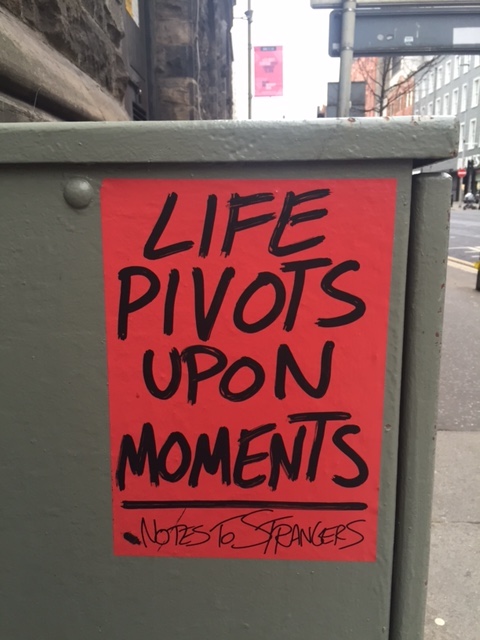
Photo: Message found in Belfast, Northern Ireland
Art therapy marks out routes of passage within a designated space, it can design sequences of movement and denote a body in motion. Compositions on the move, explorations of environment, and art influenced by context that simultaneously re-imagines space according to somatic knowledge.
The art therapy studio can include the world-at-large.
Art therapy contributes to civic dialogue – art therapy asking complicated questions about expression and representation in civil society.

Art Therapy for Social Justice: Radical Intersections (2019) edited by Savneet K. Talwar
“An underlying assumption equates social justice to access, and to fair and just treatment for all. Social justice in the mental health field (art therapy, counselling, or psychology), therefore, translates into understanding how clients are positioned in society and if they ave equal and fair less to resources and benefits. A social justice paradigm broadens the scope of practice to incorporate a critical perspective on the ways subjectivity is socially and politically constructed, and the ways history and language produce representations of non-normative identities” (Savneet Talwar, 2019, p. 11)
“An intersectional analysis of race, class, gender and sexuality, and disability inevitably leads to memory, emotions, and the body to convey the embodiment of culture” (Savneet Talwar, 2019, pg. 38)
“An art therapy practice informed by intersectionality explore the embodiment of lived experience from personal, social and political perspectives” (Savneet Talwar, 2019, p. 40)
“History always weighs on the body and its materiality. Foucault..argues that discipline creates docile bodies, which are ideal for achieving the goal of citizenship, reached though cooperation and the desire to fit within society. Good citizenship relies on internalising disciplinary powers in order to self regulate the body…Intersectionality as a methodology asks that we investigate the visible and invisible systems of power to allow for a deeper analysis of social categories of difference and the disciplinary powers that have sanctioned shame, violence and trauma, thus stigmatising the performance of non-normative bodies. The interaction between the personal and social is a political one” (Savneet Talwar, 2019, pp. 41-41)
“Public Practice Art Therapy: Enabling Spaces Across North America” by Janis Timm-Bottos (Canadian Art Therapy Association Journal, 2017, Volume 30)
- “Art is a voice that refuses to be silenced”
- “Art therapists have an important leadership role as neighbourhoods and institutions are becoming receptive sites…that welcome everyone to creatively embrace the complexities of our world” (Janis Timm-Bottos, 2017)

Photos: (Top) Art Therapy Trainees, Crawford College of Art and Design (Bottom) Moving with Graffiti alongside the Grand Canal, Dublin
Social Choreography, Constructed Situations, Tino Sehgal
German artist Tino Sehgal choreographs experiences, he constructs situations in public locations that catch people off guard, beginning conversations and contact between strangers. The orientation of his performative art form is influenced by his background as a dancer. The materials of the dance between strangers is physical presence, happenstance and discussions related to human experience and philosophy. People come together in unplanned encounters that stimulate contact through a sense of being together within a particular place and time. Participants are stopped in their paths, in order to meet within an enhanced level of human connection. Names are not important, but sharing opinions, beliefs and experiences entangle the conversation with different approaches to meaning. Sehgal’s work is not theatrical; it is a choreography with choices. It is about movement, pathways, interactions and encounters. He implicates habitual movements within public thoroughfares with surprise meetings. Somehow awakening the body, while awakening the mind, and inviting new ways of approaching everyday worlds.
Michael Klein, The Everyday Social Choreographer
- “Choreography is the act of framing relations between bodies as a way of seeing the world”
- “Choreography is not to constrain movement into a set pattern, it is to provide a cradle for movement to find its own patterns.”
- “We are inscribed with the ability to bring about changes; to create conducive conditions for things to happen, for patterning and re-patterning. Doing so is the act of the everyday choreographer” (Michael Klein, http://www.michaelklien.com)
Choreographic Elements to be explored in our social movements inspired by Rudolf Laban:
- Direct and Indirect Movements
- Slow Paced and Sudden Movements
- Light and Strong Movements
- Different Levels of Movement
- Moving in the the spherical space around the body
- Stillness
- Turning
- Gesturing
- Travel
Link for the Book of Recommendations: Choreography as an Aesthetics of Change:
Dance represents flexibility and flux, a deviation from language and fixed terms of reference. The body moves desire in a visible and amplified way. The dancer’s body invites us to imagine new positions and new courses of action. The dancer and witness are immersed together in a collaborative relationship. They move each other along and disseminate the nature of what is ephemeral. Ultimately this is about the unfixed nature of meaning and representation. The body in motion is an essential part of art therapy, and it is the primary material of art making. Space can be sculpted and animated with effort qualities that choreograph intention and direct action. To observe the physicality of art therapy is to pay close attention to the way the body moves within a given environment. Somatic reckoning permeates art therapy space, it is an inherent element of creative production.

Nancy Stark Smith, Choreography Hieroglyphs
Activating art therapy within the thresholds of physical experience is letting go of art therapy’s propensity towards order and containment. The dynamics of change are an essential aesthetic component of art therapy practice, and reside within the illustrations of movement as they manifest between therapeutic participants and art media. Art therapy evokes an ecology of circumstances, situations within which to explore movement inwards and outwards into the exteriors of personal and shared space. It is this combination, and the urge to process experience, that makes art therapy a somatic performance that marks out mobile forces of representation. The body is the living artwork, and imprints materials with surges of evocation that might be marks on paper, but equally can be made into sculptural forms that inhabit the art therapy studio. Ultimately, this instinctive choreography may result in redesigning the art therapy space through movement patterns that mark out paths of what Michael Klien terms “ungovernable moments.”
Chris Sollars, Subverting Pubic Space through Found Object Sculptures
“There is a satisfaction that comes from this unexpected audience that have to deal with these objects in space—they can avoid, destroy, or yell at me the maker. It’s a different viewing experience than art spaces with predetermined rules. My work subverts public space through interventions and performance. The results are documented using photographs, sculpture, and video that are integrated into mixed-media installations/sculptural residue. These sculptures bridge multi-disciplines that utilise different methods of display and combine into one. My work is temporal in nature and its duration can be seconds, minutes, hours, days or years. Two viewing opportunities exist for my work, first as a witness to the event itself in public and second as a viewer watching the mediated documentation of the event. This documentation is gathered and composed as an installation in order to physically position the viewer in an active role. My process is physical and conceptual as I juxtapose dissimilar elements, objects, or materials to create an unexpected form that is often comedic” (Source: Chris Sollars website, http://www.667shotwell.com)
Robin Rhodes: Wall Drawings
“Robin Rhodes explores Street art, minimalism, social practice, urban design, explorations of play, reenactment, and gesture that manifest as performance and wall drawings…Rhodes’ performances are based partially on initiation rituals that were part of his life as a teenager in high school in South Africa” (Source: http://www.artspace.com)
 Robin Rhodes, X (2010)
Robin Rhodes, X (2010)
“Take an image, let it hang in the mind, let the sensation of the thought dissolve through the body. Let the movement inside the body…move outside. Allow the sensations their own time and expression…waiting for a space between the thoughts, an unlocking of the parts of the body – a gap into which something new can emerge” (Miranda Tufnell and Chris Crickmay, Body, Space, Image: Notes Towards Improvisation and Performance).
“Where you are when you don’t know where you are is one of the most precious spots offered by improvisation. It is a place from which more directions are possible than anywhere else. I call this place the gap. The more I improvise, the more I’m convinced that it is through the medium of these gaps – this momentary suspension of reference point – that comes the unexpected and much sought after ‘original’ material. It’s ‘original’ because its origin is the current moment and because it come from outside our usual frame of reference” (Nancy Stark Smith quoted in Miranda Tufnell and Chris Crickmay, Body, Space, Image: Notes Towards Improvisation and Peformance).
“Each person is at once responsive to others and independent of them, ready to be changed by, but not absorbed into another person’s activity. The skill lies in being able to include what another person is doing, while not losing one’s own momentum of thought. Each person must become an ingredient in the mixing and making of a piece. There is no place for manners or mannerisms. Social conventions, routine habits of polite or impolite daily life, suppress the sensory and imaginative world from which this work begins” (Simone Forti quoted in Miranda Tufnell and Chris Crickmay, Body, Space, Image: Notes Towards Improvisation and Performance).
Willi Dorner: Bodies in Urban Spaces

“Bodies in Urban Spaces is a temporary intervention in diversified urban architectonical environments. The intention of bodies in urban spaces is to point out the urban functional structure and to uncover the restricted movement possibilities and behaviour as well as rules and limitations. By placing the bodies in selected spots the interventions provoke a thinking process and produce irritation. Passers by, residents and audience are motivated and prompted to reflect their urban surrounding and there own movement behaviour and habits. Bodies in Urban Spaces invites the residents to walk their own city thus establishing a stronger relationship to their neighbourhood, district and town. The interventions are temporary without leaving any traces behind, but imprints in the eye-witnesses a memory”. (Willi Dorner, http://www.ciewdorner.at)
The Art of Walking
October 4, 2018
“Walking is finding an impromptu studio in a place you never expected. Marking territory. Remembering. Picking up things. Making eye contact. A walk is never the same twice. Writing notes to self. Losing one’s way. Talking to yourself. A chat with a stranger. Going with the unexpected. Being surprised by what you find. Marking the journey with objects, the milestones of moments. Unexpected encounters. The desire to be in a new situation. Be somewhere different. Revisiting the past. Caught up with what’s going on. Making do. Taking the long way home. Getting as far away from home as possible. Being curious. Nonchalant. Indecisive. Having a route mapped out. Going off course. Letting things happen. Every so often taking a rest. Time-out. In between places. Both lingering and counting steps. Not knowing what’s around the corner” (Pamela Whitaker, The Art of Walking)
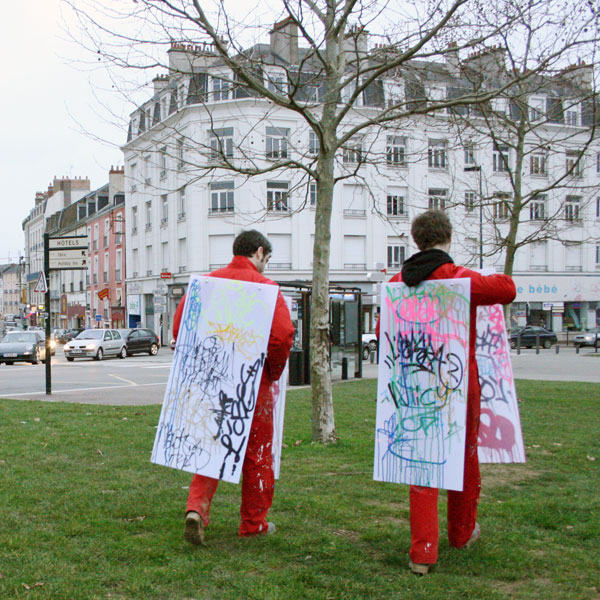
Photos: David Renault and Mathieu Tremblin, Les Frèrers Ripoulain, Human Hall of Fame, 2010, Nantes France, Walking Graffiti – Sandwich Boards for Collective Art Making
“David Renault and Mathieu Tremblin work together as Les Frères Ripoulain and their partnership seeks to address issues that they describe as ‘vandalism and anonymity, space and solitude, silence and invisibility, strangeness and secrecy…[What interests the artists is the classical graffiti tag]…not the tag’s status as ornament or decoration, but its relationship with territory—its role in the acquisition and stealing of space. Tags can be seen as the diametric opposite of commercial advertising whereby people buy space to publicise the product they want to sell.” Reference: The World Atlas of Street Art and Graffiti by Rafael Schacter.
Interartive: Walking Art/Walking Aesthetics
https://walkingart.interartive.org

Honi Ryan. Walking Presence. 2016. Photo by Kashif Saleem.
The Elastic City: Participatory Walks Curated by Artists
Photograph, Elastic City, https://www.elastic-city.org/about
https://www.elastic-city.org/about
“Elastic City intends to make its audience active participants in an ongoing poetic exchange with the places we live in and visit. Artists are commissioned by Elastic City to create their own participatory walks for the public, often using sensory-based techniques, reinvented folk rituals and other exercises to investigate and intervene in the daily life of the city, its variously defined communities, and the politics of individual and group identity”
Link to the Book Prompts for Participatory Walks edited by Todd Shalom.
https://drive.google.com/file/d/1sh-Tk50R2bT0ChRiYzJdzdWH1wetsTRv/view
Prompts for Participatory Walks
https://www.elastic-city.org/prompts
Elastic City Videos
https://www.elastic-city.org/videos
Meredith Monk and Vocal Ensemble performing Songs of Ascension at Ann Hamilton’s Tower, Oliver Ranch, Geyserville CA, Oct 2008
The Walking Lab: Performing Lines and Research-Creation
“Performing Lines: Innovations in walking and sensory research methodologies is a partnership research-creation project to study and advance the theory and practice of walking methodologies, exploring and developing innovative interdisciplinary practices”. Stephanie Springgay and Sarah Truman.



Photos Above: Walking Off Course, The First Fortnight European Mental Health Art and Culture Festival, 2019
Agnes YOSHII, Japan, Contemporary Dance Unit, Minimal Performances
Janet Cardiff and George Bures Miller, Video Walk
Produced for dOCUMENTA (13), Kassel Germany.

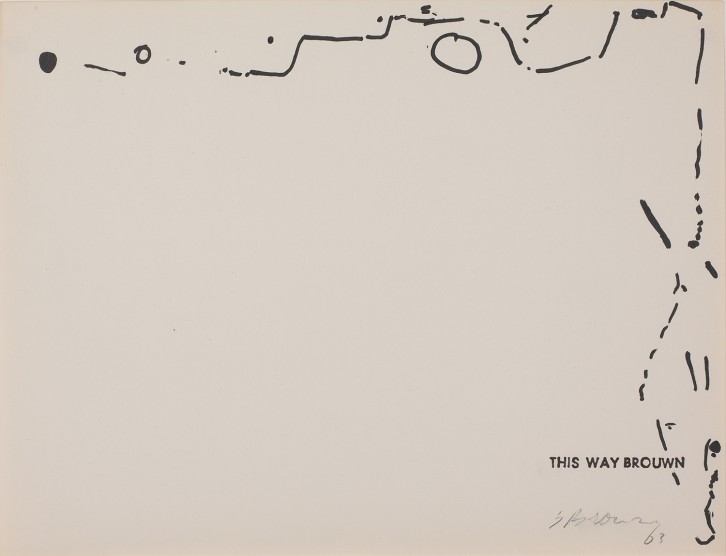

Artworks Above: This Way Brouwn and Steps of Pedestrians on Paper by Stanley Brown
“This Way Brouwn is made up of doodles drawn by pedestrians who Brouwn asked for directions, and whose simple maps he later appropriated by stamping them with the title of the series…one sheet is left blank by a passer-by who didn’t know the itinerary. The sheets, either marked or untouched, not only highlight the social dimension of walking, but also point to the subjective experience of distance and geography as opposed to the standardized conventions of cartography and topography.” (Stanley Brouwn by Jan Mot in Frieze)

Wanderlust by Rebecca Solnit Quotations
“Walkers are ‘practitioners of the city,’ for the city is made to be walked. A city is a language, a repository of possibilities, and walking is the act of speaking that language, of selecting from those possibilities. Just as language limits what can be said, architecture limits where one can walk, but the walker invents other ways to go.”
“Walking shares with making and working that crucial element of engagement of the body and the mind with the world, of knowing the world through the body and the body through the world.”
“When you give yourself to places, they give you yourself back; the more one comes to know them, the more one seeds them with the invisible crop of memories and associations that will be waiting for when you come back, while new places offer up new thoughts, new possibilities. Exploring the world is one of the best ways of exploring the mind, and walking travels both terrains.”


Photo: Artist Tehching Hsieh, One Year Performance, 1981-1982 “The artist spent a year outdoors moving around New York City with only a sleeping bag and a few other belonging” (Reference: Walking and Mapping: Artists as Cartographers by Karen O’Rourke)

Photographs: Song Dong, A Pot of Boiling Water, 1995, Beijing
Stories from the Walking Library (2014) by Deirdre Heddon and Misha Myers in Cultural Geographies

Photo: Gustavo Ciriaco, “Here Whilst we Walk”
“Inspired by the long tradition, which links walk to the production of thought and awareness, the artists Andrea Sonnberger and Gustavo Ciríaco take the public for a silent walk using as device a big rubber band. The two performers start a journey through the city, investing on the possibilities of inhabiting the urban space through another politics of sharing and of perception…A contact in displacement where the place shall always be moving and moved.” (Gustavo Ciriaco and Andrea Sonnberger)
Bruce Nauman, Walking in an Exaggerated Manner Around the Perimeter of a Square, 1967-1968.
Our Story of Resistance by Vickey Curtis, Dublin

Vickey Curtis is a spoken word artist. Her performance A Rose By Any Other Namespoke the language of street harassment in the course of a walk from the Spire to Rathmines in Dublin. Read a witnessing of her performance that was part of the Dublin Live Art Festival 2016 in:Action/Irish Live Art Review. Photograph by Blue Print Photography, Dublin.
Canadian artists Shawn Micallef, James Roussel and Game Sawhney, showcase the power voices carry to define places. They record personal stories about neighbourhoods and city streets. Murmur broadcasts oral histories for others to hear within everyday walking routes. The video above is a Ted Talk by Shawn Micallef examining the urban/suburban divide in Toronto.
Photos Above: Floats in the Aether, Amanda Coogan
“Floats in the Aether is an ambitious, large-scale performance comprising a series of events involving over 100 women and girls of different backgrounds and social contexts. In each event, Amanda Coogan will lead a silent, slow-moving, choreographed procession through the historic rooms of the National Gallery of Ireland (Dublin). Each participant wears a simple cream jacket with gold, purple, orange and green painted details to reflect the colours of the Irish suffrage movement. Coogan believes ‘this performance puts groups of women together in the spirit of community, togetherness, witness and expectation to remember and celebrate the work of the Irish suffragettes…” http://www.amandacoogan.com

Artist, Hamish Fulton, Walking On and Off the Path (2016), A walk around the west side of a mountain range, Picos de Europa in Northern Spain. Commissioned by Fundación Cerezales Antonino y Cinia, Spain.

Kathy Prendergast, City Drawings, London, 1997 Photo Source: Kerlin Gallery, Dublin, http://www.kerlingallery.com
“The map no longer offers itself as a narrative, or indeed as an interpretative tool, but is instead transformed by drawing into a zone of the imagination. This practice relates as much to a long history of artists using map images as a way of accessing states of mind and the unknown as it does to conventional map making” Reference, Frances Morris, Tate Britain, “Prendergast: City Drawings.”

Photo: Artist Susan O’Malley, A Healing Walk, commissioned by the Montalvo Arts Centre, Saratoga California

Artwork above by artist Richard Long who creates Textworks with words listing what is observed on a walk, its duration and location. Richard Long (www.richardlong.org) is a walking artist, who began his career with “A Line Made by Walking.”
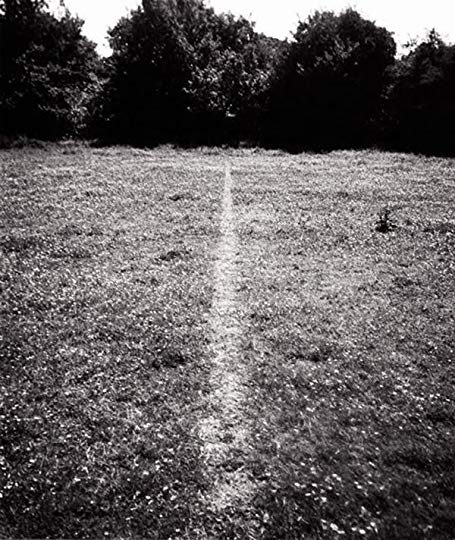
Photograph: Richard Long, A Line Made by Walking, 1967.


Artworks by Fiona Robinson, Circular Walk Drawings, 2007, http://www.fionarobinson.wordpresss.com

Photo Credit: Natalia Klishina
DESIRE LINES: CHOOSING TO WALK AWAY FROM AN ESTABLISHED ROUTE. A PERSONAL CHOICE. A CHANCE TO IMPROVISE AND BE INVENTIVE. SOMETIMES CALLED SOCIAL TRAILS, THEY ARE A WAY TO BE WITH OTHERS WHO HAVE ALSO DECIDED TO VEER AWAY. CONSIDERED A FORM OF DISOBEDIENCE, A SOCIAL CONSENSUS, AND A WAY TO BE MORE EFFICIENT IN PUBLIC SPACE, DESIRE LINES ARE DRAWN WITH SELF-DETERMINATION AND AGENCY—”DRAWINGS WE HAVE LIVED.” (GASTON BACHELARD, THE POETICS OF SPACE).



Photos Above: The Art of Walking—artworks created on a footpath beside Castletown River, Co. Louth, Ireland and a young participant creating a line while walking. The walk was an intergenerational collective of walking artists of all ages. Participants created artworks from natural collections which were left on footpaths, and made artworks with imprints from flowers and botanical finds.
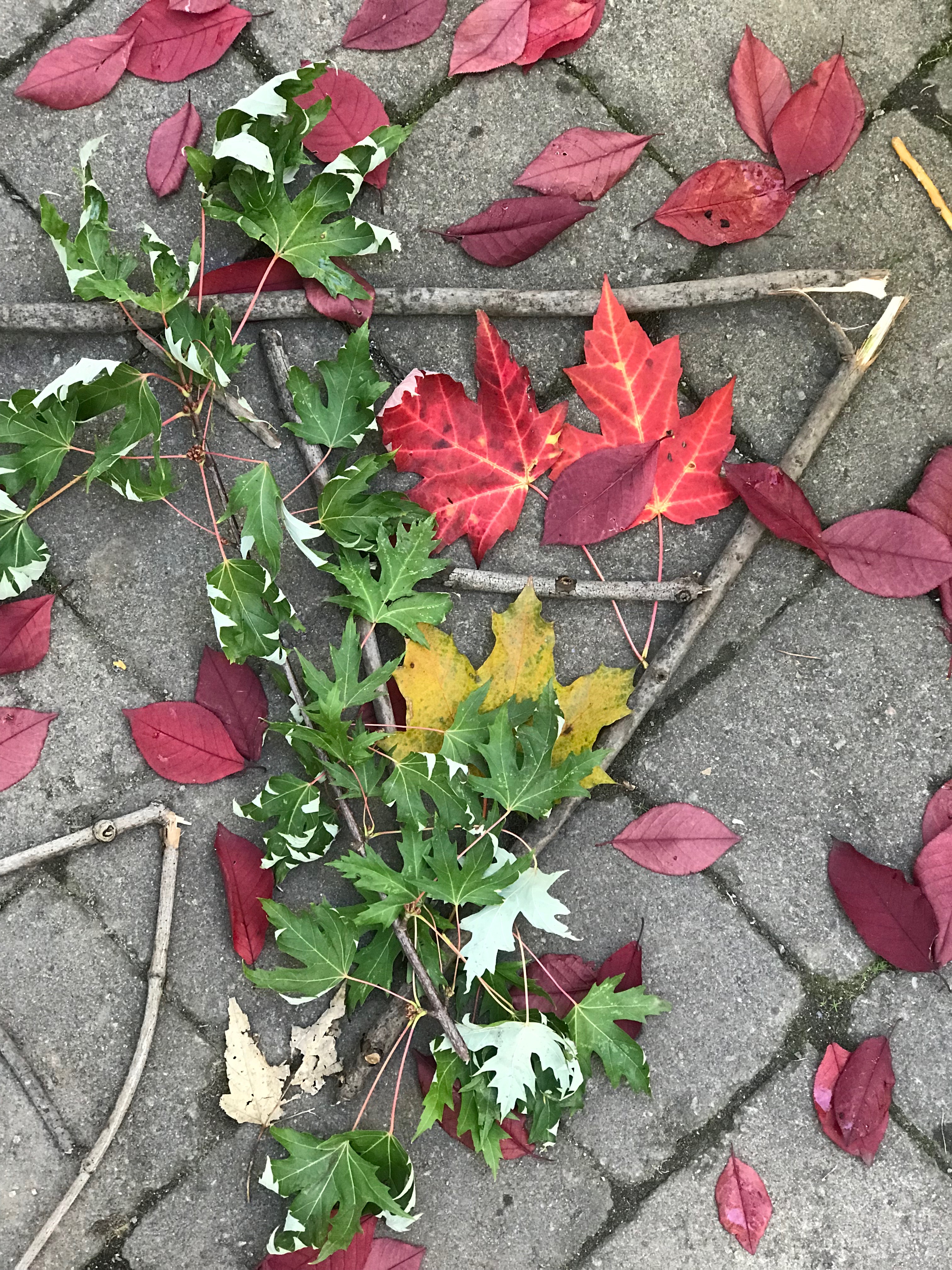

Photos Above by Santoshi Roberston Davis, The Art of Walking at the Canadian Art Therapy Association Conference in Montreal. The workshop for conference participants included a walk to the gardens of the former Grey Nuns Convent (now part of Concordia University), and the Canadian Centre for Architecture sculpture park, gallery, and gardens. The walk was researched by Janis Timm-Bottos (Associate Professor, Art Therapy, Concordia University), so that each stop included a historical and social context for participants to better understand the significance of every location along the walking route.

“Last Friday, I toured the streets of Vancouver blindfolded, guided by a woman I’d never met before – and had never seen. Do You See What I Mean? is a work of one-on-one theatre created by Lyon, France-based choreographers/artists Martin Chaput and Martial Chazallon, whose company Projet in situ describes the work as “the choreography of participation.” They’ve mounted the piece – tailored for each place – in several cities, including Montreal; it’s now in Vancouver, as part of the PuSh International Performing Arts Festival.
This was a rare moment: when my thoughts drifted beyond what was directly in front of me. During the tour, you are totally focused on your experience and its implications. You’re not checking your phone, you’re not casing the room, you’re not thinking about anything other than the steps you’re climbing, the lavender pastry you’re tasting, the exchange you are having with your guide. Your mind does not wander at all. At least mine didn’t – and that is a feat for me. I didn’t – couldn’t – take a single note. But I remember everything. Do You See What I Mean? is set firmly in the world we’re already in, but have long forgotten to notice. We become intrigued again with the streets we walk every day” (Extracts by Marsha Lederman, ‘Why I Walked Blindfolded in Vancouver for Two Hours’)

Marina Abramovic and Ulay, The Great Wall Walk (1988). The meeting of Marina and Ulay after each walked 90 days from either end of the Great Wall of China. While initially planned as a celebration of their twelve year artistic and personal relationship, their meeting (documented above) marked the end of their collaboration and partnership.
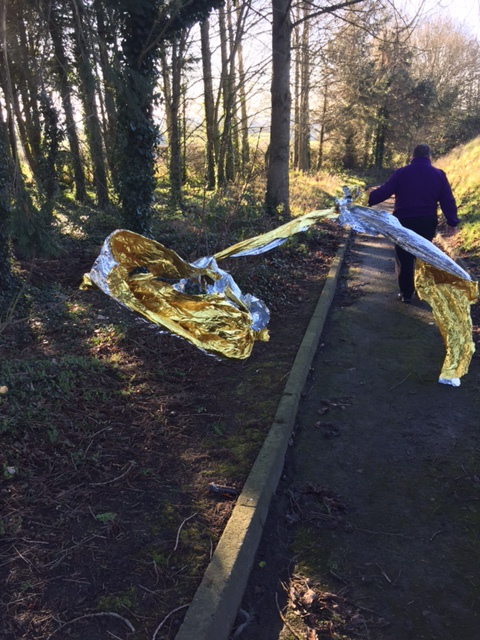
Photo: A walk in an art therapy forest studio, Ireland.
Further Reading
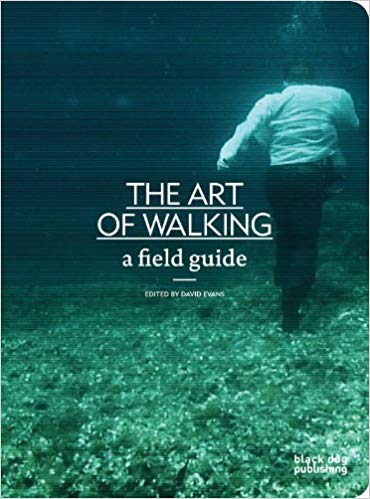

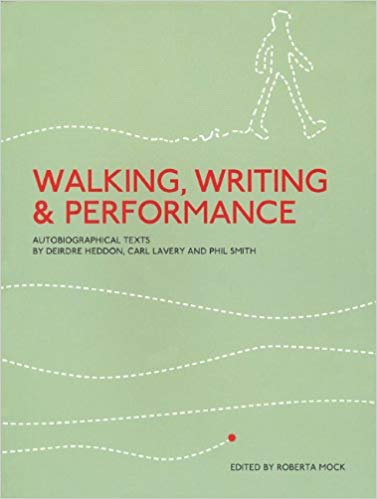

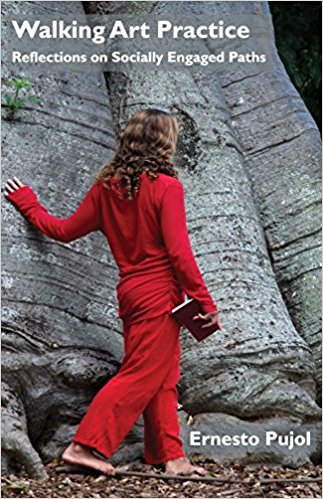

WALK: University of Sunderland’s Walking Art, Landskip and Knowledge Research Group
A Listing of Walking Artists by www.glasstire.com/The Ten List: Walks as Art
Walk Poems: A Series of Reviews of Walking Projects by Louis Bury and Corey Frost
The Loiterers Resistance Movement
The Sideways Art Festival, A Walking Expedition through Belgium
Walking Artists to Discover
Richard Long, Hamish Fulton, Alec Finlay, Marina Abramovic, Chris Drury, Mike Collier, Brian Thompson, Tim Brennan, Tim Robinson, Julian Opie, Bruce Nauman, Melanie Manchot, Richard Wentworth, Francis Alÿs, Janet Cardiff, Atul Bhalla, Simon Pope, Sophie Calle, plan b, Wrights & Sites, Dan Holdsworth, Rachel Reupke. Joe Bateman, Brendan Stuart Burns, Rachael Clewlow, Sarah Cullen, Bradley Davies, Tracy Hannah, James Hugonin, Tim Knowles, Pat Naldi & Wendy Kirkup, Ingrid Pollard, Bryndis Snæbjõrnsdóttir & Mark Wilson, walkwalkwalk, Jeremy Wood, Catherine Yass, Carey Young.
Art Therapy and Ecology 4
January 17, 2018
Photos from Top to Bottom: Anya Gallaccio ‘That Open Space Within”, herman de vries ‘Forest Collage’ and David Nash ‘Ash Dome Drawing’
“Movement, change, light, growth and decay are the life-blood of nature, the energies that I try to tap through my work. When I work with a leaf, rock, stick, it is not just material in itself, it is an opening into the processes of life within and around it. When I leave these processes continue.” (Andy Goldsworthy)
Why Art in Nature? The purpose of art making in nature is to experience the natural environment as an outdoor studio and to work with living art materials. It’s an opportunity to explore working with both found natural materials that make marks (i.e. mud, grass, berries, flowers, and charcoal) and to also investigate working with larger sculptural forms that evoke the idea of shelter within forest habitats. Equally, the acts of walking and collecting can be understood as important artistic practices.
Collected objects from nature can be assembled into displays where textures, colours and patterns are highlighted. Since natural materials gradually decompose photography, sketching and writing can be used to document artworks made in the forest. The nature studio offers many experiences to perceive ecology, and to structure these perspectives into a variety of artworks that will explore lines, shapes, dimensions, and patterns found in the natural world. Land Art is an intriguing form of contemporary art which works within a variety of natural environments, transforming living materials into distinct compositions. Nature is unpredictable and constantly changing – these are also the features of environmental art made outdoors within different kinds of habitats.
“I use the world as I find it…A sculpture I’ve made along the way is a sort of celebration of that place, of me being there at that time in that state of mind. It’s a record of that moment in my life.” (Richard Long)
Photos: Andy Goldsworthy, ‘Sticks in River’ (Top) David Nash ‘Ash, Branch, Cube’ (Below)
What is Land Art? Land art is usually made in relation to a specific landscape or location, using collections of natural materials found on site. Land art can be left within the landscape, to be affected by the elements, or it can be transported into a studio space or gallery. This form of art is subject to change, it is ephemeral subject to decay and the impact of ecological processes including the effects of weather. Land Art can also incorporate walking, as a way of drawing upon the landscape. Walking artists consider forest paths to be like lines of drawing, a way of making one’s mark by foot, or taking a line for a walk. Walking artists Richard Long and Hamish Fulton use collections of words to illustrate their journeys through landscapes. Long uses the term textworks to describe the way individual words can encapsulate the essence of nature walks.
Photos from top to bottom: Andy Goldsworthy ‘Rowan Leaves with Hole’, Hamish Fulton ‘Rock, Fall, Echo, Dust”, Chris Drury ‘Shimanto River Sphere’, and Richard Long ‘A Line Made By Walking’
I want an intimate physical connection with the earth. I must touch. I take nothing out with me in the way of tools, glue or rope, preferring to explore the natural bonds and tensions that exist within the earth. The season and weather conditions determine to a large extent what I make. I enjoy relying on the seasons to provide new materials. (Andy Goldsworthy)
What Kinds of Natural Materials can be used for Land Art? Charcoal (collected from abandoned campfires), Berries, Grass, Mud, Seed Heads, Leaves, Moss. Pine Cones, Pine Needles, Roots, Weeds, Flowers, Stones, Logs, Bark and Branches
Photos: A Textwork by Richard Long ‘Day to Day’ (Top) and Patrick Dougherty ‘Childhood Dreams’ (Bottom)
I enjoy the freedom of just using my hands and “found” tools – a sharp stone, the quill of a feather, thorns. I take the opportunities each day offers: if it is snowing, I work with snow, at leaf-fall it will be with leaves; a blown-over tree becomes a source of twigs and branches. I stop at a place or pick up a material because I feel that there is something to be discovered. Here is where I can learn. (Andy Goldsworthy)


Photos of Art Therapy Bundles, Made from Branches, Felt, Fibre Materials


Top Photo: Miguel Angel Blanco, ‘Library of the Forest’, nature collections in wooden “book” boxes that are journals of his walking journeys.
The idea of a book being a collection of objects that are ideas, moments of time, a landscape, and movements held within a box vessel, can be a vital medium of artistic practice within art therapy. A walk can be taken alone or accompanied by others, either can become documented as an art therapy journey that involves the surrounding habitat as living studio. The words of thought and feeling held within the significance of objects selected, illustrate and enact a psychological quest. This is a language of wandering and finding significance in what is close at hand. The book is an installation that can be handled and read in many ways. Time is contained within the dimensions of the book’s architecture. The composition of the book, reveals itself as a structural building, a home place for an ephemeral story.
Websites for Inspiration
- Green Museum The Online Museum of Environmental Art
- Women’s Eco Artist’s Dialog
- Chris Drury
- herman de vries
- Richard Long
- Hamish Fulton
- Patrick Dougherty
- Also Search online for Artist Anya Gallaccio
Materials and Preparation List
Fully charged camera phone or camera for photography
Sketch book or notebook for drawing, for imprints of natural materials, creative writing, and ideas you wish to take away from the workshop
Pencils and pens, graphite, charcoal or pastels for drawing and writing in sketchbook
Tape for attaching foraged items into sketchbook
Containers or bags for foraged items. These materials can be used for artworks after the workshop.


Photos: Collections of nature by artist herman de vries


Photo: A print of a tree trunk and a drawing of a forest walk
Photos: Ecole du cloitre Vic sur Seille, Les Photos de Marc Pouyet

Photo: Kriss MacDonald, “My Botanical Desk – Winter Nature Diary”
Photos: Shelters Made in a Ravensdale Forest, County Louth
Photo: Nils-Udo ‘The Nest’
Photo: Chris Drury ‘Pine Circle, Cone Sphere’


Photo: Derek Jarman photographed by Terry O’Neill (The Guardian)
Derek Jarman (1942-1994) was an English film director, artist, writer, stage designer and gardener. His garden journals, reflections and nature based artworks are profiled in his book Derek Jarman’s Garden. Written before his death the book crusades the proliferation of personality in every garden, rather than codification and regulation. Out of a shore composed of flint and shingle, and near a nuclear power station in Dungeness, Kent, Jarman created a gardening legacy that acts as a stage for not only his own personal experiences, but a catalyst for the pursuits of others who follow his example. An activist opposed to lawns, garden chemicals and the dictation of order, Jarman encouraged a garden’s anarchy and wild abandon. His garden was without borders and conventions, extending in all directions and inwards to meet the realities of landscapes both human and natural. His home, a restored fishing cottage, became his sanctuary and studio for forays into various forms of contemplation and artistic enterprise. The garden is still today infused with the magic of surprise. “I saw it as a therapy and a pharmacopoeia” (Derek Jarman), its essential nature to assist with the experiencing of life cycles.

Photo: Derek Jarman’s Garden
“Derek Jarman gave his garden a certain narrative; perhaps he treated it a bit like a film or theatre set. His films were visionary, eccentric, romantic and rebellious, all of which could also be said about his garden. The plants were distinct players in the action…He put wild with cultivated, made art out of rubbish and declared the garden a gallery where nature played the most important part. He sought refuge in his garden, but chose a setting with no boundaries, where everything is an edge: shingle, sea, sun, wind all shifting and changing…It is a weird and wonderful place, but in many ways humble: a small house, a tiny garden, yet the maker showed us all how wild and brilliant our own spaces can be if we’re prepared to look sympathetically at the landscape around us, to make room for the flotsam and weeds in life as much as the jewels.” (Alys Fowler, “Gardens: Planting on the Edge in Derek Jarman’s Garden”, The Guardian, September, 24, 2014

Photo Source: Gardenista

Photo Source: Kriss MacDonald, Derek Jarman’s Garden
Art Therapy and Ecology 3
January 16, 2018
Photo: An art therapy forest studio, County Louth
A Forest Studio
A forest studio can be foraged for art materials, it can also be the site for installations, walks, photography, writing, sketching, printmaking, journaling, enactments and the making of artist books. Celebrations and gatherings also invite festivity into the forest.


Photos: Ravensdale Forest Land Art and Archway Blackrock Forest Garden, Co. Louth
“Sitting in a wilderness [forest] garden you can almost hear the generative power of nature. It is like watching a speeded-up film, when buds uncurl, flowers open and shrubs expand as if by magic. If we were to leave a patch of land free from human intervention – no cropping, mowing, digging or ploughing – it would quickly revert to its natural state…It is this feeling of wild, unfettered energy one seeks to create in a therapeutic garden” (Dondald Norfolk, The Therapeutic Garden)
Forest gardening is a practical means of cultivation, it involves low maintenance in regards to watering and weeding. The forest garden appears chaotic and dishevelled, and yet its layered design is a complex arrangement of companion planting. It is a self-regulating habitat, an ecological system, which benefits both mind and body. “If a garden is to mirror [human] nature it must be varied, irregular, random and wild” (Donald Norfolk, The Therapeutic Garden).



Photos Top to Bottom: Willow woven hut for children, land art workshop display and willow woven seat in Blackrock Forest Garden and Ravensdale Forest, Co. Louth
A community garden can also be a habitat for art therapy, art and participation, or arts and health. Blackrock Playground Park (Blackrock, Co. Louth) has a dedicated edible forest garden. The garden was originally planted with local environmental volunteers, children and families living around the park. Working with neighbours (of all ages) to cultivate a “commons” or supportive habitat within the pathways of everyday life, an edible forest garden is an example of therapeutic gardening that embraces nature as a regenerating source of well being. Edible wild plants, hedgerow and orchard fruits, herbs, vegetables, medicinal plants and living art materials (e.g. willow for living sculptures, plants for natural dyes, and symbolic plants associated with Irish seasonal traditions) grow together as a large scale public artwork. Not only is the food plentiful, its design is self sustaining, engaging itself in its own reproduction and fertility.

Photo: Blackrock Forest Garden, County Louth
“Many gardening words and expressions illustrate how steeped the language of cultivation is in the vocabulary of personal growth and nurture…transplanting, uprooting, flowering, blossoming, digging deep, grounded, putting down roots, cutting back, branching out, growing new shoots, shedding, weeding out…”
Quotation from Sonja Linden and Jenny Grut, The Healing Fields: Working with Psychotherapy and Nature to Rebuild Shattered Lives

Photo: A family artwork for Samhain, Blackrock Forest Garden, County Louth
“The range of art materials available from an outdoor art therapy studio invites perceptive stimulation and can be combined with more commonly used art therapy materials in either indoor or outdoor settings. Land-sourced art materials (e.g. soil, clay, stone, sand, seaweed, shells, weeds, charcoal, ash, water, grasses, pine cones, pine needles, roehips, seeds, flowers, ferns, nuts, lichen, [moss], mud, bark, herbs, leaves, berries, and edible plants), along with landscape-inspired fibre arts materials (e.g. wool, felt, thread, handmade paper, beeswax, fleece, and natural fabrics), and construction materials for installation spaces (e.g. wood, branches, and straw bales) all invite imaginative responses that add to the participation evoked by more traditional art therapy materials…
Land sourced art materials, fibre art materials, and construction materials can extend the textures, dimensions, and sensations gained from more frequently used art [therapy] media. For example, paint, glue, clay or melted beeswax can be combined with leaves, pine needles, grasses, seeds, rosehips, or flower petals. Paper can be marked with mud, charcoal, soil, ash, [pollen, flower pigments], and berry juices…Pinecones, dried herbs, flowers, and leaves can be strung together and suspended from an indoor ceiling or used to embellish an outdoor den, or even worn draped across the body. Mud, dirt, berry juices, and charcoal can “paint” the skin for use in art therapy enactments, with the pigments of these materials colouring the body canvas.”
(Quotation from Pamela Whitaker, “Groundswell: The Nature and Landscape of Art Therapy” in Materials and Media in Art Therapy: Critical Understandings of Diverse Artistic Vocabularies by Catherine Hyland Moon)

Photo: Grand Canal Dock, Dublin
References for Art Therapy and Nature
Green Studio: Nature and the Arts in Therapy by Alexander Kopytin and Madeline Rugh (Editors), Nova Publishers
Nature-Based Expressive Arts Therapy: Integrating the Expressive Arts and Ecotherapy by Sally Atkins and Melia Snyder, Jessica Kingsley Publishers
Environmental Arts Therapy and the Tree of Life by Ian Siddons Heginworth
Environmental Arts Therapy Website by Ian Siddons Heginworth
“Taking Art Therapy Outdoors: The ‘Greening’ of Art Therapy Practice” by art therapists Vanessa Jones and Gary Nash, BAAT Newsbriefing, July 2017. Contact Vanessa Jones and Gary Nash at the London Art Therapy Centre, where they teach a course called Environmental Arts Therapy Training with drama therapist Ian Siddons Heginworth. They also offer introductory level courses. Courses are held on weekends in London parks and woodlands. London Art Therapy Centre
The Healing Fields: Working with Psychotherapy and Nature to Rebuild Shattered Lives by Sonja Linden and Jenny Grut
The Healing Forest in Post-Crisis Work with Children: A Nature Therapy and Expressive Arts Program for Groups Ronen Berger and Mooli Lahad, Jessica Kingsley Publishers
The Nature Therapy Centre by Ronen Berger
The Therapeutic Garden by Donald Norfolk, Bantam Press
“Groundswell: The Nature and Landscape of Art Therapy” in Materials and Media in Art Therapy: Critical Understandings of Diverse Artistic Vocabularies by Catherine Hyland Moon

Photo: An art therapy forest studio, County Louth
Community Gardening: Cultivating an Art Therapy Studio
Benefits to Wellness
- Skill Sharing and Learning among Peers
- Collaboration, Mentoring, Teamwork
- Social Interaction
- Achievement and Self Esteem
- Cultivating nature, Enhancing the World for Oneself and Others
- Working with symbols of Regeneration (Growth) and Cycles of Change
- Physical release of Tension and Stress
- Pride of Place, Making a Difference in the World
- Mind Wandering and Reverie in Gardening and Aesthetic Experience enhances Cognitive Flexibility for Problem Solving
- Soil bacteria Mycobacterium vaccae releases Serotonin to Decrease Anxiety and improve Cognitive Functions, Enhance Mood and Coping Abilities.
- Foraging and Harvesting assist in the release of Dopamine which may promote Energy and Enthusiasm.


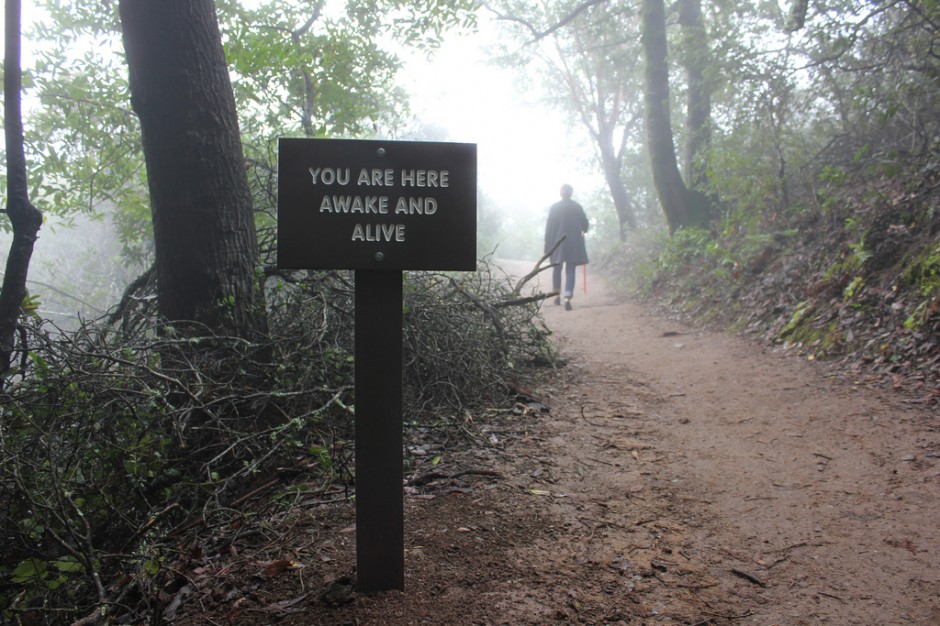

Photo: Artist Susan O’Malley, A Healing Walk, commissioned by the Montalvo Arts Centre, Saratoga California
Art Therapy and Ecology 2
January 15, 2018

Photo: Pamela in her garden
“For most people, art has nothing to do with ecology, or our relationship with environment…Yet ecology, or environment, is where we live, where all life lives – it is where cultures lives, where the arts and human endeavor lives, since culture also cannot be outside the world.” (Beth Carruthers, “Art, Place and the Meaning of Home,” Essay for the Vancouver Parks Board).
In his book An Ecology of Enchantment, Canadian gardener Des Kennedy has written that “a garden is a work in progress, an artistic exercise that’s never finished, but at every stage of its existence stirs with the excitement of the creative process. The notion of the gardener as a pilgrim denotes a journey of discovery, of learning as we go. Gardening is the chance to live in touch with the earth, to find ourselves within its seasonal turnings, and to truly appreciate the extraordinary beauty of each ordinary day”.
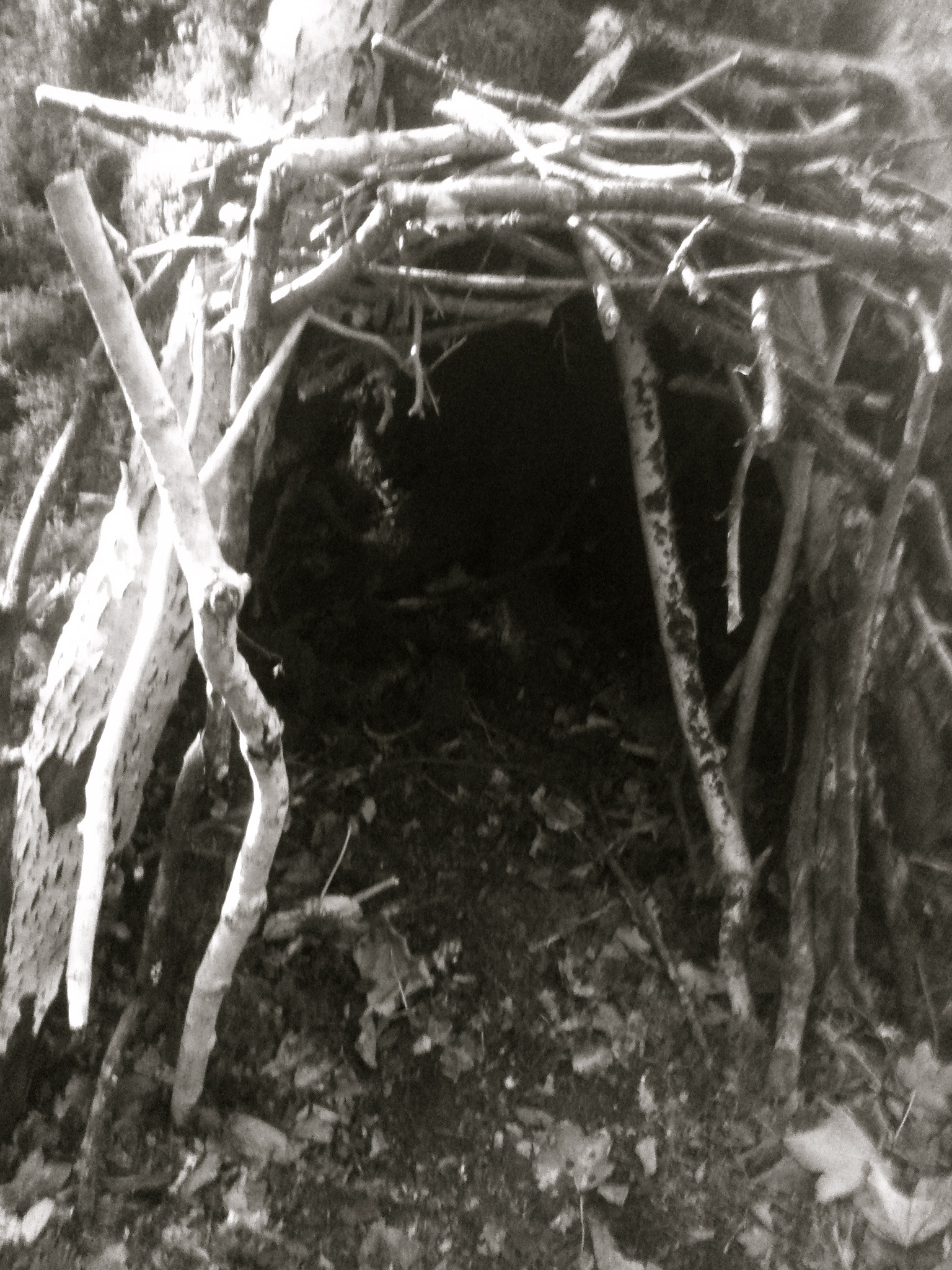
Photo: Shelter made in Ravensdale Forest, Co. Louth
“The natural world is a vital and alive medium for art therapy…The outdoors can be experienced as a signifier for the extension of therapeutic practice into the world at large. The use of gathered, rather than bought, art materials fosters a sensing of one’s way through tactile exploration. The outdoor landscape offers a nomadic sense of exploration and spontaneity, mediated by surroundings that are not predetermined by function. This exterior space can offer the potential for rambling and gathering, a place for physical immediacy within many spatial dimensions that stimulate creative investigations. ..The reverie encountered when working within a natural landscape challenges one to view art therapy not as the creation of images, but rather as an overall experience of assembly…In this context, subjectivity relates to a natural terrain that is continually in flux, a mirroring of one’s own nature in motion amid changing circumstances”
(Quotation from Pamela Whitaker, “Groundswell: The Nature and Landscape of Art Therapy” in Materials and Media in Art Therapy: Critical Understandings of Diverse Artistic Vocabularies by Catherine Hyland Moon)
Inspiration for Outdoor Studios with Applications for Art Therapy
Sharon Kallis
“Sharon Kallis is a Vancouver artist who specializes in working with unwanted natural materials. Involving community in connecting traditional hand techniques with invasive species and garden waste, she creates site-specific installations that become ecological interventions” (New Society Publishers, Author Description). She works with a “one-mile diet” approach to sourcing materials that are freely available and close at hand.
“In community outdoor work, my creative process begins with a harvest principal that embraces communal stewardship of the land; weeding, invasive species removal, coppicing, gleaning and gathering. Oral traditions of knowledge sharing occur; my own experience with plants and their uses are exchanged with those familiar to a place through close investigation of the surroundings, walking, sharing stories about the landscape and observed shifts in eco-systems. Installation ideas spring forth through conversation, idea sharing, identifying what materials are suitable for harvest and the consideration of the inherent physical properties of both place and material used.”
Sharon Kallis has written a book called Common Threads: Weaving Community Through Collaborative Eco-Art.
EartHand Gleaners Society
The East Hand Gleaners Society in Vancouver is a collective of artists who work with art, ecology and place. The word “gleaner” means to “gather something slowly and carefully in small pieces” (https://www.vocabulary.com/dictionary/gleaner).
“By working with the plants around us using ancestral skills common to all cultures, we inspire participants to discover cultural connections, learn new skills, and discover novel sources of raw materials for creative practices, including garden waste, invasive plants, and textile waste.”
Oliver Kellhammer
“I take biological systems and I remix them. In the way a DJ would remix music, I remix ecosystems and plants” Oliver Kellhammer
“Oliver Kellhammer is an ecological artist, educator, activist and writer. Through his botanical interventions and public art projects, he seeks to demonstrate nature’s surprising ability to recover from damage. His work facilitates the processes of environmental regeneration by engaging the botanical and socio-political underpinnings of the landscape.”

Oliver Kellhammer, Means of Production Garden, Vancouver
Artist Statement
“I am interested in exploring the processes of ecological regeneration in the wake of human disturbance, either through passive field observation (what can I not do?)… or by actively engaging the biological and socio-political processes that inform these landscapes by attempting to improve their relationships with each other. The latter approach often takes the form of what I call botanical interventions, whereby I employ horticultural techniques to mitigate problems between people and the landscape, enhancing both the sense of place and the ecological carrying capacity of a given site, as well as addressing such problems as erosion, food availability and the lack of local agency over the design of urban spaces.”
“Perhaps we can afford to give up a little control to let this second ‘nature’ take its course. We’ll need to learn to tolerate a few weeds, a little uncertainty and a little mess, but we might just learn something” Oliver Kellhammer
The Means of Production Garden, Vancouver
The Means of Production Garden in Vancouver grows living art materials for use by artists and community groups. Founded by artist and activist Oliver Kellhammer and the Environmental Youth Alliance in Vancouver (with land supplied by the Vancouver Parks Board) it offers “open source” resources that are harvested for “community creative use.” Kellhammer believes than an open source landscape encourages experimentation with botanical materials and an investigation into art and ecology.
There is willow for sculptures, flax growing for linen, plants for natural dyes, and foraged natural materials for weaving and fibre arts. Skill sharing, social gatherings, artist residencies and celebrations prevail within this artists’ garden. Kellhammer’s philosophy regarding open source landscaping encourages nature to enter the urban world in unpredictable ways. Kellhammer also believes that self-seeding trees, flowers, and weeds erupting along the edges of urban areas, may also stimulate experiments in community living.
The Means of Production garden is a living art installation. It is a gathering place for community, and an ecological art form. According to Kellhammer it is a biological intervention. Inspired by Nicolas Bourriaud’s Relational Aesthetics which encourages the practice of art within social environments, Kellhammer’s living art acts as an event, and ecological improvisation. Curating gardens as art projects, can develop gathering spaces for spontaneous interactions. Gardens themselves are unpredictable happenings, where irregular growth cycles, weeds, decay, and weather all influence ever changing conditions. Gardens can be both public art forms and places/acts of environmental and community activism.
Common Ground
Common Ground is a charity, based in Dorset, UK that explores the relationship between nature and culture,”seeking imaginative ways to engage people with their local environment.”
Common Ground “plays a unique role in linking nature and culture, working to inspire, inform and involve people in learning about, enjoying, and taking more responsibility for their own locality. We champion popular involvement and inspire celebrations as one starting point for local action to improve the quality of ordinary places and everyday lives” (Common Ground, “ABC: Learning to Read Your Locality,” brochure)
Local Distinctiveness
Local distinctiveness is “the web of rich understandings between people and their land and their histories, it is not about scenery, it takes us below the surface, to where the land might reflect back to us purpose and belonging. Sometimes we forget that our everyday surroundings are nature’s greatest reservoir, history’s biggest book…By focussing attention on significance in our surroundings and helping build courage to be demonstrative and to take action on attachment to place, then perhaps we can make our surroundings better for nature as well as daily life” (Common Ground, “ABC: Learning to Read Your Locality,” brochure)
“We sometimes forget [that we live in] a cultural landscape.”
“Local distinctiveness is essentially about places and our relationship with them…Places are process and story as well as artefact, layer upon layer of our continuing history and nature’s history intertwined…Meaning is entrapped in the experience of change [and] symbolism and significance cling to seemingly ordinary buildings, trees artefacts…
“Locality needs to be defined from the inside, with a cultural and natural base…”
“We are talking of quality in the everyday…[which] involve[s] emotional attachment…”
(Quotations Above, from “Losing Your Place” an article by Sue Clifford and Angela King in a book produced by Common Ground called Local Distinctiveness: Place, Particularity, and Identity)
Art Therapy and Ecology 1
January 7, 2018
Photo: Mud and gold paint 1
Ecology Definitions:
1. The study of the relationships between living organisms and their environment.
2. The set of relationships of a particular organism with its environment.
3. The study of the relationships between human groups and their physical environment.
(Source: Collins Dictionary Online)
Workshop Information for MA Students in Art Therapy, Crawford College of Art and Design, Cork Institute of Technology
Groundswell is a social enterprise that works in the areas of art therapy, organic horticulture, environmental education, arts and health, and art and participation.
“The environmental practices of Groundswell are aimed at developing biodiversity habitats combining…[edible plants], herbs, fruits, wildflowers, and indigenous trees. This method of networking domestic and ecological territories facilitates a consideration of both the cultivated and wild landscapes in which we live, engendering an appreciation for relationships between nature and culture as contexts for daily living. For example, gardens can generate an interest in both the productive and creative aspects of horticultural growing. They are cultural spaces that reflect interactions between human nature and ecology. Making art within a natural setting expresses themes related to growth, decay and processes of change, as well as cultural traditions associated with different seasons of the year. Groundswell links people, ecology, and place…The natural world’s aliveness and diversity illuminate the potential for artistic exploration that unites the materiality of the natural world with the materiality of the human condition…infusing art therapy with new frontiers of accumulative creation.”
(Quotation from Pamela Whitaker, “Groundswell: The Nature and Landscape of Art Therapy” in Materials and Media in Art Therapy: Critical Understandings of Diverse Artistic Vocabularies by Catherine Hyland Moon)
Making a Scene in Public: Art Therapy and Ecology Workshop
This workshop for art therapy students at the Crawford College of Art and Design will explore the creation of land art within the nature of public spaces. Working with found and natural materials in outdoor studio areas, artworks will relate to both personal and collective themes. Therapeutic situations will be encountered en route through the examination of outdoor habitats. We will consider how art therapy can be choreographed through spontaneous relations with environment. Artworks will be both site specific and portable, assembling ingredients of location in an attempt to enact the energies of participants with the character of place.
Workshop Themes
Art Therapy Out of Bounds
Social Environments
Land Art
Enactments
Choreography of Space
Therapeutic Situations
Habitats
Conditions of Nature
The Artistry of Location

Photo: Mud and gold paint, 2
Editorial Quotations, Art Therapy and Environment, Canadian Art Therapy Association Journal.
Whitaker, Full Editorial, Art Therapy and Environment
A Natural Response to a Natural Disaster by Jess Linton (free access until March, 2018)
“An art therapy environment is both an art form and a place of production.”
“Art therapy environments are ecologies that produce particular conditions for creation.”
“Environment is not neutral.”
“The surroundings of art therapy are the starting point.”
“Art therapy can craft habitats.”
“Art therapy can find its place within social environments and form a sense of locality or residency within society on the move.”
“Art therapy’s environment is more than the boundaries of a frame. It can be an encounter, a happening, or a situation in the making.”
“The totality of an art therapy location can be a physical environment for art.”
“An art therapy environment is not a background, but the scene for experiences in the making.”

Photo: Mud and gold paint 3




